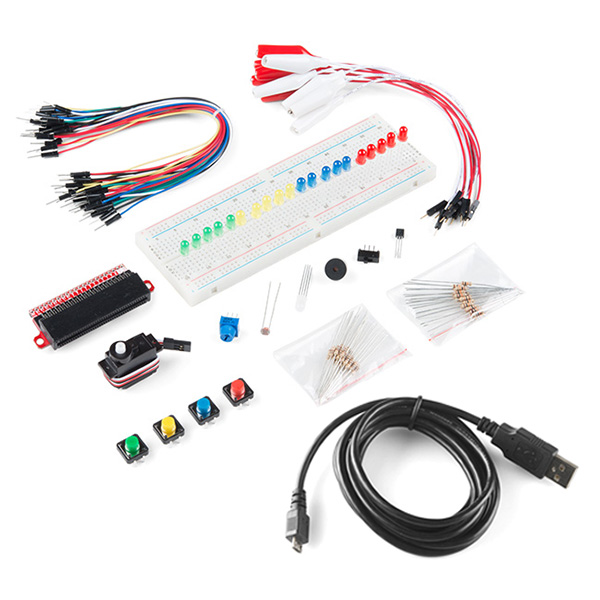SparkFun Inventor's Kit Bridge Pack for micro:bit
Do you own a micro:bit or micro:bit Go Bundle and want to expand your skills with the new microcontroller? You are in luck! The SparkFun Inventor's Kit Bridge Pack for micro:bit was designed to provide you with an easy way to transform your m:b into a full fledged learning kit! Each Bridge Pack includes all of the parts found in the SIK for micro:bit that aren't included with the Go Bundle. With the SIK Bridge Pack for micro:bit you will be able to complete circuits that will teach you how to read sensors, move motors, build Bluetooth® devices and more.
The micro:bit is a pocket-sized computer that lets you get creative with digital technology. Between the micro:bit and our shield-like bit boards you can do almost anything while coding, customizing and controlling your micro:bit from almost anywhere! You can use your micro:bit for all sorts of unique creations, from robots to musical instruments and more. At half the size of a credit card, this versatile board has vast potential!
Note: The Bridge Pack is NOT a full SparkFun Inventor's Kit and only includes the parts to complement a micro:bit Go Bundle or standalone board. That also means that this kit does not include a micro:bit, which will need to be purchased separately.
- SparkFun micro:bit Breakout (with Headers)
- Full-Size Breadboard
- Small Servo
- TMP36 Temperature Sensor
- Photocell
- USB Micro-B Cable --- 6 Foot
- Jumper Wires
- Alligator Clips with Pigtails
- RGB Diffused LED
- Red, Blue, Yellow and Green LEDs
- 10K Trimpot
- Multicolor Button --- 4-pack
- SPDT Mini Power Switch
- Mini Speaker
- 100 Ohm Resistors (Thick Leads)
- 10K Ohm Resistors (Thick Leads)
- Circuit 0: Hello, micro:bit!
- Circuit 1: Blinking an LED
- Circuit 2: Reading a Potentiometer
- Circuit 3: Reading a Photoresistor
- Circuit 4: Driving an RGB LED
- Circuit 5: Reading an SPDT Switch
- Circuit 6: Reading a Button Press
- Circuit 7: Reading the Temperature Sensor
- Circuit 8: Using a Servo Motor
- Circuit 9: Using a Buzzer
- Circuit 10: Using the Accelerometer
- Circuit 11: Using the Compass
SparkFun Inventor's Kit Bridge Pack for micro:bit Product Help and Resources
SparkFun Inventor's Kit for micro:bit Experiment Guide
July 21, 2017
This guide contains all the information you will need to explore the twelve circuits of the SparkFun Inventors Kit for micro:bit.
Getting Started with the micro:bit
September 2, 2021
The BBC micro:bit is a compact, powerful programming tool that requires no software installation. Read on to learn how to use it YOUR way!
micro:bit Breakout Board Hookup Guide
June 17, 2021
How to get started with the micro:bit breakout board.
Getting Started with MicroPython and the SparkFun Inventor's Kit for micro:bit
July 11, 2017
Learn MicroPython with the micro:bit.
Core Skill: Robotics
This skill concerns mechanical and robotics knowledge. You may need to know how mechanical parts interact, how motors work, or how to use motor drivers and controllers.
Skill Level: Noob - You will be required to put together a robotics kit. Necessary parts are included and steps will be easy to follow. You also might encounter basic robotics components like bearings, mounts, or other hardware and need a general idea of how it goes together.
See all skill levels
Core Skill: Programming
If a board needs code or communicates somehow, you're going to need to know how to program or interface with it. The programming skill is all about communication and code.
Skill Level: Rookie - You will need a better fundamental understand of what code is, and how it works. You will be using beginner-level software and development tools like Arduino. You will be dealing directly with code, but numerous examples and libraries are available. Sensors or shields will communicate with serial or TTL.
See all skill levels
Core Skill: Electrical Prototyping
If it requires power, you need to know how much, what all the pins do, and how to hook it up. You may need to reference datasheets, schematics, and know the ins and outs of electronics.
Skill Level: Rookie - You may be required to know a bit more about the component, such as orientation, or how to hook it up, in addition to power requirements. You will need to understand polarized components.
See all skill levels
Comments
Looking for answers to technical questions?
We welcome your comments and suggestions below. However, if you are looking for solutions to technical questions please see our Technical Assistance page.
Customer Reviews
4 out of 5
Based on 1 ratings:
Every pin is broken out well
Lots of fun components to make toys and experiments with. Decent breadboard. Plenty of jumper wires and alligator clips.
The servo is pretty erratic if you’ve tied it to the 3.3V of the micro:bit. If you give it 5V on power and use the micro:bit for commands it works much better.
One cool cheap project to consider for a future version would be to have a few more buttons and add diodes, to make a key matrix.

